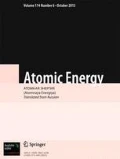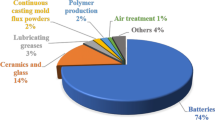It is shown that dialysis cells with a sedimentary membrane spontaneously forming from reaction products can be regarded as an effective method for reprocessing the radioactively contaminated liquid media. The studied cell was created on the basis of a commercially produced anisotropic microfiltration element made of fibrous polypropylene. The dialyzer operated in a regime of continuous purging of the separation chamber of the cell by an upward flow of the processed solution. An advantage of dialysis cells is the high quality of the separation of truly dissolved impurities and the dispersed component. The separating efficiency of the components increases when a single reagent is simultaneously dosed into the flow. In the present work, K4[Fe(CN)6] and Na2SO3 were dosed into the processed solution. The chemical composition and the size of the particles in the processed solution as well as the characteristics of the solid phase formed in the settling tank and on the surface of the dialysis cell are presented.
Similar content being viewed by others
References
S. S. Ostalkevich, V. E. Tregubova, and A. V. Safonov, et al., “Biological purifi cation of liquid NAO from metals and nitrate ions,” in: Current Problems of Nuclear-Chemical Technologies and Environmental Safety, Sevastopol (2016), pp. 145–148.
A. V. Safonov, V. E. Tregubova, E. V.Zakharova, et al., “Microbiological approach to the purifi cation of liquid radioactive waste,” At. Energ., 114, No. 6, 349–351 (2013).
A. S. Volkov and E. M. Nalivaiko, “Radioactive waste management at the No. 1 unit at the Novovoronezh NPP-2 of project NPP-2006,” Izv. Vyssh. Uchebn. Zaved. Yad. Energet., No. 3, 183–194 (2017).
A. G. Pervov and N. A. Matveev, “Rational use of water based on reverse osmosis technology for water treatment and wastewater treatment,” Vodooch. Vodopodg., Vodosnab., No. 11, 40–44 (2013).
A. E. Savkin, D. V. Adamovich, and M. D. Bely, “Management variants for radioactive waste from nuclear power plants,” Vopr. At. Nauki Tekhn. Ser. Materialoved. Nov. Mater., No. 3 (78), 87–95 (2014).
Z. Holicka, T. Krajc, D. Kevicky, et al., “Experience with operation of mobile cementation facility at A-1 NPP,” in: Proc. 12th Int. Conf. on Environmental Remediation and Radioactive Waste Management, Liverpool (2009), pp. 55–59.
S.-T. Hwang and K. Kammermeyer, Membrane Separation Processes, Khimiya, Moscow (1981).
L. N. Matusevich, Crystallization from Solutions in the Chemical Industry, Khimiya, Moscow (1968).
Chemical Encyclopedia, Bol’shaya Ros. Entsikl., Moscow (1992), Vol. 3/5.
Α. Α. Svitsov and T. Zh. Abylgaziev, “Micellar-enhanced (reagent) ultrafi ltration,” Usp. Khimii, 60, No. 11, 2463–2468 (1991).
Α. Α. Svitsov, B. E. Ryabchikov, and S. B. Khubetsov, “Technology for reprocessing liquid radioactive waste by micellar enhanced ultrafi ltration,” Vodootchistka, No. 1, 45–48 (2010).
V. E. Plushenko and V. D. Stepin, Analytical Chemistry of Rubidium and Cesium, Nauka, Moscow (1975).
V. P. Shvedov, L. M. Ivanova, and V. I. Zharikov, “Separation of radioactive cesium from seawater. I. Separation of cesium in the form of compounds with zinc, copper and nickel ferrocyanides,” Radiokhimiya, 5, No. 2, 182–185 (1963).
L. M. Ivanova and V. P. Shvedov, “Separation of radioactive cesium from seawater. II. Separation of cesium in the form of compounds with alkaline earth element ferrocyanides,” Radiokhimiya, 5, No. 2, 185–189 (1963).
D. V. Adamovich, A. E. Arustamov, V. M. Gelis, et al., Patent for Invention No. 2320406, “A method of obtaining a ferrocyanide sorbent,” Byull. Izobret. Polezn. Modeli, No. 9, 1–6 (2008).
T. Vincent, C. Vincent, and E. Guibal, “Immobilization of metal hexacyanoferrate ion-exchangers for the synthesis of metal ion sorbents – a mini-review,” Molecules, 20, No. 11, 20582–20613 (2015).
L. Sharygin, A. Muromskii, M. Kalyagina, et al., “A granular inorganic cation-exchanger selective to cesium,” J. Nucl. Sci. Technol., 44, No. 5, 767–773 (2007).
L. M. Sharygin and A. Yu. Muromskii, “Inorganic sorbent for ion selective treatment of liquid radioactive waste,” Radiokhimiya, 46, No. 2, 171–175 (2004).
L. M. Sharygin, A. Yu. Muromskii, V. E. Moiseev, et al., “Sorption treatment of liquid radioactive waste from nuclear power plants,” At. Energ., 83, No. 1, 17–23 (1997).
B. Figueiredo, S. Cardoso, I. Portugal, et al., “Inorganic ion exchangers for cesium removal from radioactive wastewater,” Sep. Purif. Rev., 47, No. 4, 306– 336 (2018).
V. D. Nikitin, E. M. Yakimets, N. A. Timakova, et al., “Obtaining internally complex compounds of ethylenediaminetetraacetic acid with cations of certain metals and methods for their analysis,” in: Trilon B Application in the Analysis of Non-Ferrous Alloys, Sverdlovsk (1963), pp. 94–103.
S. A. Simanova (ed.), New Handbook for Chemists and Technologists. Chemical Equilibrium. Properties of Solutions, NPO Professional, St. Petersburg (2004).
Author information
Authors and Affiliations
Corresponding author
Additional information
Translated from Atomnaya Énergiya, Vol. 127, No. 5, pp. 263–269, November, 2019.
Rights and permissions
About this article
Cite this article
Chugunov, A.S., Vinnitskii, V.A. Dialysis Membranes Based on Microfiltration Elements for Separating the Components of Npp Radioactive Wastewater Via Precipitation. At Energy 127, 288–295 (2020). https://doi.org/10.1007/s10512-020-00625-3
Received:
Published:
Issue Date:
DOI: https://doi.org/10.1007/s10512-020-00625-3




